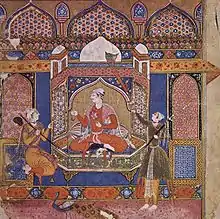Shree (Hindustani raga)
Shree is a very old North Indian raga of the Purvi thaat, and has traditionally been associated with Shiva. It also appears in the Sikh tradition from northern India, and is a part of the Guru Granth Sahib, the holy text of the Sikhs.[1] The Guru Granth Sahib composition comprises 31 ragas where Shree is the first raga to appear. The raga appears first on 14th page of the composition.
 | |
| Thaat | Poorvi |
|---|---|
| Time of day | Early evening, after sunset |
| Season | Winter |
| Arohana |
|
| Avarohana | Ṡ N Ḏ P M̄ G Ṟ S |
| Pakad | S, Ṟ Ṟ P, P M̄ G Ṟ ❟ Ṟ Ṟ ,S |
| Vadi | Ṟ |
| Samavadi | P |
| Synonym | Shri |
| Hindustani classical music |
|---|
| Concepts |
| Genres |
| Thaats |
The basis of this Raag is steeped in the traditions of mainstream Indian Classical music. Siri Raag is serious and thought-provoking in its nature and creates an atmosphere where the listener is led to heed the advice given therein. The listener (the mind) is made aware of the truth of the message and with this ‘education’ is given the strength to face the future with both humility and the ‘gained’ knowledge.
Guru Nanak, Guru Amar Das, Guru Ram Das, and Guru Arjan have composed sacred hymns (Shabads) to be accompanied with this raga. It accompanies about 142 Shabads.
According to Indian classical vocalist Pandit Jasraj, Shree is "an evening raga, sung during the sunset. It is full of grace and majesty, and the main mood it creates is one of devotion and dedication."[2]
See also
Film songs
Language : Hindi
| Song | Movie | Composer | Singers |
|---|---|---|---|
| Prabhu Charanon Men | Andolan(1951 film) | Pannalal Ghosh | Parul Ghosh |
Language : Kannada
| Song | Movie | Composer | Singers |
|---|---|---|---|
| Hadonda Haaduve | Naandi (film) | Vijaya Bhaskar | P. B. Sreenivas |
Language : Telugu
| Song | Movie | Composer | Singers |
|---|---|---|---|
| Nelaraja Vennela raja | Malliswari (1951 film) | S. Rajeswara Rao | P. Bhanumathi |
References
- Singha, H.S. (2000). The Encyclopedia of Sikhism (over 1000 Entries). Hemkunt Publishers. p. 10. ISBN 978-81-7010-301-1. Archived from the original on 26 May 2021. Retrieved 26 May 2021.
- "Indian classical music: Different kinds of ragas". The Times of India. Times Group. 29 September 2016. Archived from the original on 10 May 2021. Retrieved 10 May 2021.
External links
- Rajan Parrikar's page on raga Shree
- Deepak Raja's article on raga Shree
- More details about raga Shree